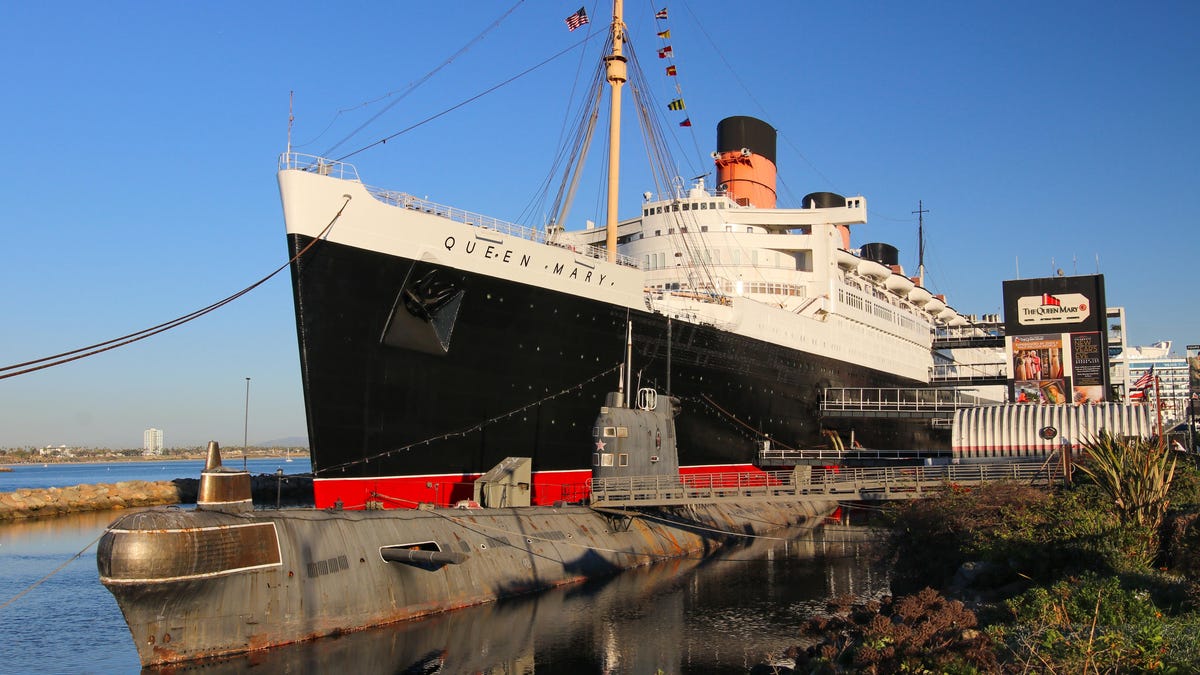 Why You Can Trust CNET
Why You Can Trust CNET Legend of the seas: a look inside the massive RMS Queen Mary
Bigger than the Titanic, and the finest transport of her day, the RMS Queen Mary is now a museum and hotel. Here’s the full tour.

She was the most luxurious way to travel. Over 1,000ft (300m) long, 12 decks, and with a lavish art deco interior. Royalty, statesmen and hundreds of thousands of troops enjoyed her accommodations as she crisscrossed the Atlantic for 31 years.
She's the RMS Queen Mary, built in Scotland in the early 1930s. Now she sits in Long Beach, south of Los Angeles. And she's not just a museum and ship-out-of-time, but she's also a working hotel housing guests in a unique setting -- minus any chance of seasickness.
Shipshape and seaworthy
Launched in 1934, the RMS Queen Mary was Cunard-White Star Line's flagship for the next 10 years. Fast and modern, she was capable of over 30mph (50kph), while coddling her thousands of passengers in the greatest luxury of her day. Her well-heeled passengers anyway.
The rich and famous walked her decks, including Audrey Hepburn, Bob Hope, Fred Astaire, and Elizabeth Taylor. Another Elizabeth, the Queen Mother, crossed the Atlantic on the ship named after her mother-in-law. Winston Churchill adored the ship and traveled on board several times. Eisenhower, Jackie Kennedy and Robert Kennedy spent time aboard as well.
Though fast, technology was already catching up when she was new. Air travel was still in its infancy, but airship travel was hitting its one and only peak. Compare, for similar money, what you'd get on the Queen Mary versus the state-of-the-art Hindenburg, which would get you across the Atlantic in less than half the time.
Perhaps her most important mission was during World War II. She was converted to a troop ship, first ferrying Aussie and New Zealander troops to the UK, and then later, US troops across the Atlantic. She was able to carry an amazing 15,000 soldiers per journey, and in total, 765,429 during the war.
During one such trip a rogue wave nearly capsized the ship, which inspired Paul Gallico to write "The Poseidon Adventure." Three years later the movie adaptation was, in turn, shot on board the Queen Mary. Dozens of other TV shows and movies have used her decks as a set too, partly for her lovely design and looks, but also her unique availability in the zone.
The Queen Mary's post-ship life has been varied. Deemed a "building" by the US Coast Guard, much of her interior was removed and sold for scrap: Boilers, generators, one of the engine rooms, one of the two swimming pools and all the staterooms other than the first-class cabins. The captain's cabins, one of the engine rooms and many other areas remain -- plus they are well maintained. Restoration is ongoing, which isn't surprising given the age of the ship, the salty air and water.
If you stay on board, you have largely the same access as the tours. The "hotel" rooms are the former first-class cabins and staterooms, and there are multiple restaurants as well as a gorgeous bar.
As a visitor, you can wander around on your own or take one of the several different guided tours. I recommend these as they're quite informative and in my experience, having visited here many times since I moved to LA, the docents and tour guides are exceptionally friendly as well as knowledgeable. For this visit, we were shown around by the charming Commodore Everette Hoard, who seems to know and is known by everyone.
The Queen Mary, with the Grand Princess.
B-427 Scorpion
Moored next to the Queen Mary is the Foxtrot-class diesel-electric submarine B-427, nicknamed "Scorpion." She served in the Soviet/Russian navy from 1971 to 1994. For most of the 2000s she was a museum ship, but in 2012 she'd developed a serious leak and has been closed to the public since. I've included a couple of photos I took of the B-427 when I visited many years ago. Digital cameras have come a long way, as you'll see.
If you'd like some better images inside a Foxtrot-class submarine, I toured the B-39 at the San Diego Maritime Museum.
All Aboard
The Queen Mary is open every day, with various types of tours and events available depending when you go. A combo ticket is available for the QM and the nearby USS Iowa. You can book one of the hotel rooms on any hotel booking site, or via the ship's website. According to the Commodore, it's best to book well in advance. Otherwise, check out the photos in the gallery above.
As well as covering audio and display tech, Geoff does photo tours of cool museums and locations around the world, including nuclear submarines, aircraft carriers, medieval castles, epic 10,000-mile road trips and more.
Also check out Budget Travel for Dummies, his travel book, and his bestselling sci-fi novel about city-size submarines. You can follow him on Instagram and YouTube.

